As it stands, it is more novelty than game changer, but if you are set on the Note 4 and don’t mind spending the extra cash there is no reason not to opt for the Note Edge.
The Samsung Galaxy Note Edge offers everything we love about the Samsung Galaxy Note 4 with the addition of curved AMOLED technology that creates a unique secondary display. It takes some getting used to, and functionality is limited for now, but the phone’s Edge display offers a novel experience that subtly enhances usability without sacrificing performance.
What’s Different
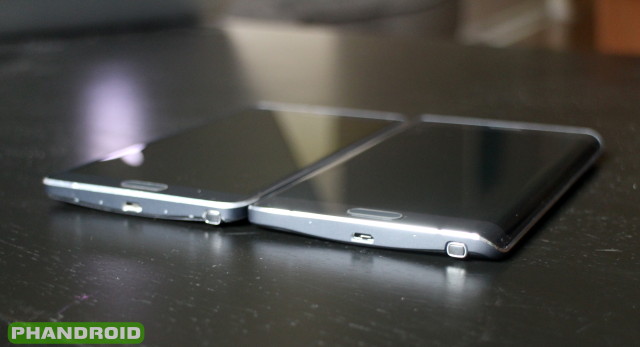
Aside from the obvious inclusion of the Edge display, there are a few key differences between the Galaxy Note 4 and the Note Edge, most of them superficial. Because of the curved AMOLED design, the shape and size of the phone are altered slightly amounting to a device that is slightly wider.
The Note Edge measures 5.96 x 3.24 x 0.33 inches compared to the Note 4’s 6.04 x 3.09 x 0.33-inch frame. The Note Edge comes in a hair lighter than the Note 4 at 6.1 ounces.
In terms of hardware the major changes include a Super AMOLED display smaller that that of the Note 4. The 5.6-inch display of the Note Edge doesn’t feel any smaller than the 5.7-inch screen of the Note 4, especially taking into consideration the added benefit of the Edge display. The Note Edge also has a 3,000mAh battery, 220mAh less capacity than the standard Note 4.
The overall design of the Note Edge stays in line with that of the Note 4, including Samsung’s faux-leather material on the rear of the device. The left half of the phone is more-or-less identical to the Note 4. It’s the right side with its cascading side display that is the Note Edge’s biggest departure from the design of the Note 4.
This review will continue to focus on the Note Edge’s curved display and accompanying functionality. All other hardware and design aspects, including the Note’s S-Pen stylus, are covered in our full Galaxy Note 4 review.
The Edge Display
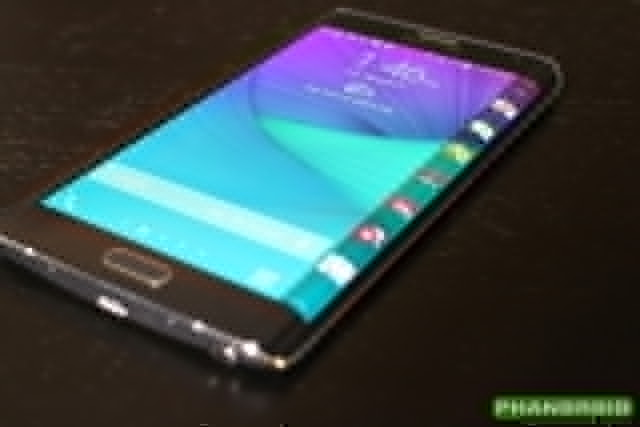
Physically, the Edge display takes some getting used to. A standard-looking AMOLED display takes a downward curve toward its right edge. The display rests under its matching curved glass, both aspects are continuous from the main display to the Edge display. The Edge portion features a resolution of 2,560 x 160 pixels.
The curve is close to a 45-degree angle and terminates sharply where the display glass meets the back of the phone. The created edge isn’t the most ergonomic design of all time, but it doesn’t create any immediate discomfort. Because of the placement of the Edge display, users will need to adjust their typical smartphone grip a bit in order to avoid accidentally tapping icons or content.
The Edge display serves two primary functions within the Note Edge’s Android presentation: acting as a shortcuts drawer and providing at-a-glance access to notifications. Both elevate the Edge display from novelty to something quite utilitarian in overall presentation of the Note Edge.
It’s an adjustment from the standard Android (and smartphone, for that matter) interface to constantly reach for your most-used shortcuts to the right of the display rather than the bottom, but it’s a smart one on Samsung’s part. Relocating the shortcuts frees up more of the main display’s screen real estate for widgets and other homescreen modifications. There is also enough room on the Edge display to include a few more shortcuts than you would otherwise be able to. Note that not all apps can be added as an Edge display shortcut.
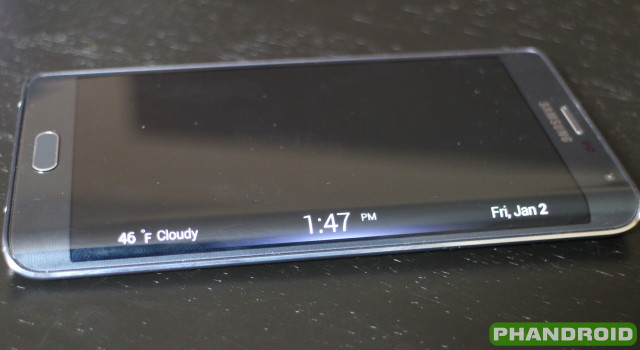
The Edge display works well as a notifications ticker. You can swipe through alerts, missed calls and texts — the display works particularly well for displaying the content of incoming messages. The display also operates independently of the main screen, meaning you can discretely glance at incoming notifications while your phone rests on the table or desk in front of you. For those curious, notifications still appear in the standard pull-down drawer accessible from your homescreen.
Other Software Functions
There is, of course, more to the Edge display than what we have discussed so far. While out of the box the Note Edge is set up to serve shortcuts and notifications from the curved portion of its display (and this is ultimately what the Edge display does best), there is a bit more to it.
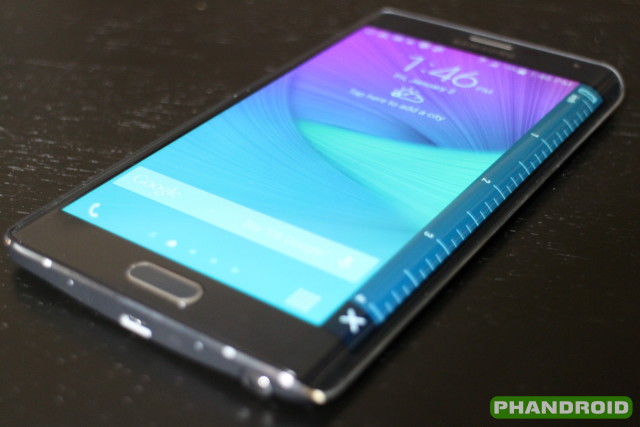
Swiping down for the top of the Edge display serves up a drawer of tool shortcuts. The most unique of which is one that only a device like the Note Edge could take advantage of: a ruler. Yes, it’s ultimately a bit useless. It only measures up to 4 inches, and you could just as easily gauge the length of something of that size by simply comparing it to the actual Note Edge.
With the phone’s display off, you can view only the curved edge by swiping your finger along its curve. This will show the date and time as well as weather and other notifications with brief previews depending on the comment. You can further swipe through the various Edge screens without lighting up your entire device, perfect for discretely checking incoming notifications during a meeting or at other inopportune times.
A night clock mode dimly illuminates the Edge display with the date and time, acting as replacement to the alarm clock on your nightstand. Be warned that while it isn’t a huge impact, this will slowly drain battery life while you sleep if the device is left off the charger.
One use of the Edge display demonstrates how such technology can be used in more innovative and intriguing ways. The shutter button of the camera software has been relocated from its place on the main display to along the curve, mimicking the placement of the shutter button on traditional cameras. It might take a bit of getting used to, but once you are familiar with the change it feels totally natural.
The Edge display settings menu provides for some cursory customizations to give it a look and feel that better suits your style, and Samsung has no plans to keep their curved AMOLED off limits from developers. Content is rather scarce other than the functions already provided by Samsung, but we are interested to see if any developers out there jump on the bandwagon.
A note for left-handers
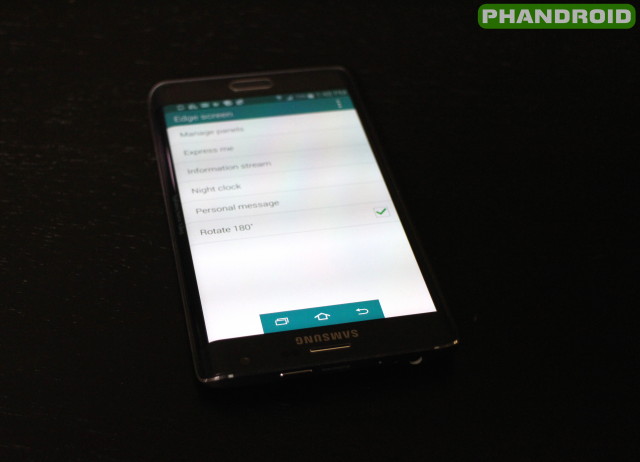
Within the Edge display’s settings menu is an option to allow the screen to rotate 180 degrees. This allows those left-handers among us to use a device that was no doubt designed for righties. Since the phone is held upside-down to achieve this affect, this creates the issue of the Note Edge’s hardware navigation buttons now being located at the top of the display. Samsung has solved the issue by providing software alternatives that can be accessed by swiping up from the bottom of the display. It’s not perfect, but it’s the best solution lefties have right now.
Battery Life
The Note Edge features a smaller battery than the Note 4, and its battery life does suffer slightly. 3,000mAh of power capacity still provide about a day of life on normal use. Vegging out on video or using the Edge as a gaming machine will obviously have their impacts, but even then the phone should pull a respectable 10-12 hours per charge with heavy use.
The Note Edge, as with the Note 4, contains quick charge technology that allows users to restore about 50% of battery life in only 30 minutes. The Edge lived up to these numbers, and charging really is pretty painless.
Is there better battery life out there with other Android devices? Most assuredly. But the Note Edge still offers strong battery performance that is aided by its ability to charge quickly when needed.
The Bottom Line
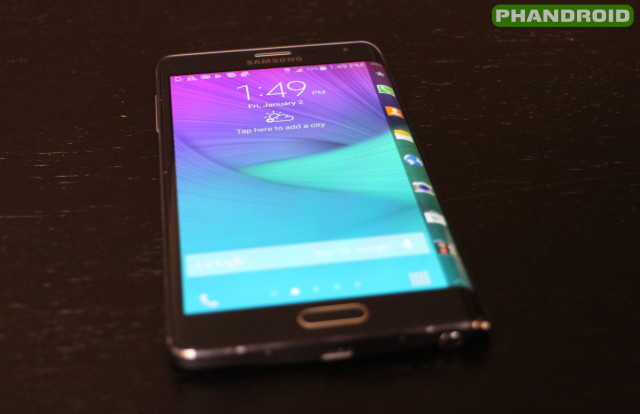
The Samsung Galaxy Note Edge takes everything we like about the Note 4 and enhances it with its Edge display. Is it enough to say it is a better overall phone? The answer to that still isn’t quite clear. While the Edge display has its advantages with quick access to shortcuts, notifications, tools, and other content, its tough to say these features are worth the added cost of owning the Note Edge.
The Note Edge retails for $399.99 with a two-year contract. The Galaxy Note 4 is a full $100 cheaper, and there are equally strong smartphones that can be purchased contract-free for the same price or only a little more than the Edge.
In the end we give Samsung an ‘A’ for effort. It’s refreshing to see a phone that not only tries something new while pushing the technological limits of smartphones forward, but the Edge display still doesn’t feel like a must-have feature. As it stands, it is more novelty than game changer, but if you are set on the Note 4 and don’t mind spending the extra cash there is no reason not to consider the Note Edge.
The Good
- Innovative Edge display adds functionality to the Note 4 design
- At-a-glance notifications offer distraction free use
- Shortcuts on Edge display free up space on the main homescreen
The Bad
- Can be slightly awkward to hold/takes some getting used to
- No perfect solution for left-handers
- Battery life slightly worse than standard Note 4.
Overall: 4.5/5



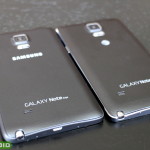
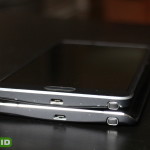
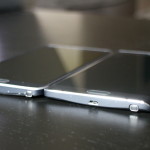
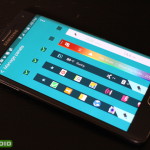
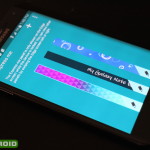
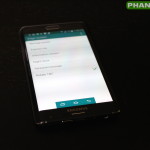
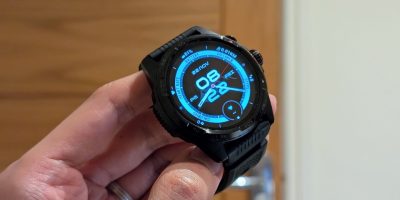









I thought this was a cool idea when it was first announced….now I just think its an awkward phone when I see it. I’m really not sure why anyone would buy this phone for the crazy amount they are asking….then again, I bought the Nexus 6 haha
This phone falls under the Samsung logic of “why the hell not?” Good for Samsung for trying something different, even if it most likely is a gimmick that won’t be used beyond bar tricks after the honeymoon is over. I look at it this way. It’s the first of it’s kind. Let’s give them time to work out the issues.
cant argue with that logic….has this phone been profitable for them?? or is safe to call it kind of a disaster?
The limited availability and price makes me think it’s not a success. I could be wrong.
that is something I would love to see….its rare to see just how many phones they end up selling until so far down the road (if not ever).
It’s early days yet. Don’t call it a failure just yet.
Well in Japan at least if you want a 2014 Note it has to be the Edge as they are not releasing the 4 there
I have the edge and I love it so far
Ditto, hoping for some developers to get behind this phone , I think theres allot more potential then at first glance.
Would I pay an additional $100 to get the Note Edge over the Note 4? Probably not. If they were priced the same, i would definitely consider it. But in the end i would probably choose the Note 4 since i do not see much of a use for the Edge display. Ideally Samsung should price these the same.
This phone wasn’t meant to be a huge profit generator. It’s a pilot program of sorts – Samsung is most likely using this to gauge the market’s reaction before moving forward with other curved SAMOLED displays on smartphones. I think curved SAMOLED will be a big hit for smartwatches and eventually smart glasses, but I think Samsung is throwing the Note Edge out there as a trial balloon before deciding to implement the technology further in their smartphone lineup.
The Note 4 and the Edge are equally great phones but I went with the Edge over the 4 as the 4 really isn’t that much different than the Note 2 I had a little over a year ago functionality and feature wise minus the heart rate sensor. I really like this phone/phablet and I hope more developers get on board with custom edge panels other than Yahoo and CNN currently. I considered the 6+ for the screen size and Touch ID but Apple and it’s developers have a long way to go before their apps are tailored for that bigger screen. The Edge is definitely a one of a kind phone and if you want something that won’t seem like it’s behind the “curve” a year from now the Edge is definitely the way to go. The best way to get this phone (at least for me) was on the AT&T Next plan. $399 is way to much to pay up front for any phone. Rumors are the S6 will have a curved display but we’ll see and reportedly only one million of these Edge’s will be made. The future looks bright for Sammy!
Great phone! Love it. If u r considering the 4 and can Afford it, get it. The edge really helps. It’s not just a gimmick.
iSheepers are drooling… the Edge 5.6″ but look and holding way better than 5.5″ iPhone 6plus because iPhone physical size is bigger the Edge and even the note 4 and #bendgate.
I love Android but Bendgate is completely overblown.
So the pros/cons don’t include whether or not a “slight” drop is more of a problem over the note 4
I LOVE my Galaxy Note Edge on T-Mobile and since it is one of the few phones that support T-Mo’s new 700MHz frequency….YAY…..
700 has been standard on flagships since 2012. Even the GS3 has it.
But in T-Mobile’s case 700MHz is not in the GN3 only in the GN4 and GNE and new phones being released in 2015…
You could take an original Note from 2011 and get 700MHZ LTE.
T-Mobile uses 700MHz block A spectrum frequency so that would not have worked…
No review ever mentions wether or not the Edge is compatable with the Gear VR. You’d think that would be included. Especially in a direct comparison review like this.
CNet 2010: More
than just a gimmick, the Samsung Continuum’s secondary display is a
useful management and multitasking tool, but its constant flow of
information might not appeal to everybody.
Phandroid Today: The Edge display serves two primary functions within the Note Edge’s
Android presentation: acting as a shortcuts drawer and providing
at-a-glance access to notifications. Both elevate the Edge display from
novelty to something quite utilitarian in overall presentation of the
Note Edge.
I just hope that Samsung decides not to abandon its customers with the Continuum 2 like they did with its predecessor. It launched on Eclair in late 2010, right around the time when Gingerbread came out. Sixteen months later — well after ICS was released — it got an update to Froyo.
I’m impressed with the innovation of the Edge and most hopeful that 3rd party developers take the edge of the Edge in unforeseen directions.